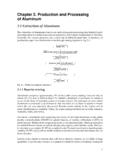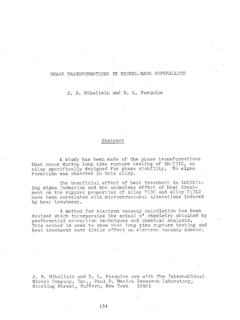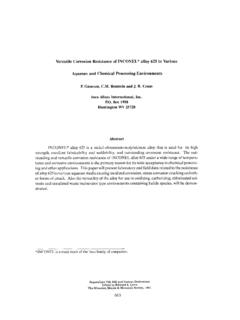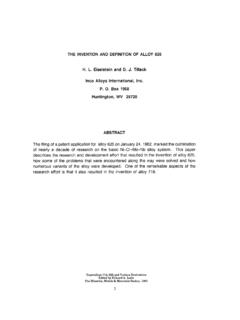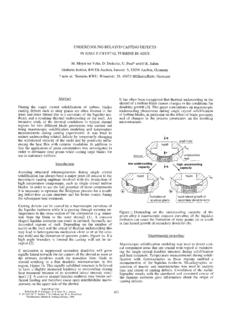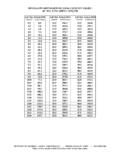Transcription of The Effect of Laves Phase on the Mechanical …
1 THE Effect OF Laves Phase ON THE Mechanical PROPERTIES. OF WROUGHT AND CAST + HIP INCONEL 718. John J. Schirra, Robert H. Caless, and Robert W. Hatala United Technologies Corporation Pratt & Whitney East Hartford. Connecticut 06108. Abstract The Effect of varying amounts of Laves Phase on the Mechanical properties of wrought and cast + HIP Inconel718 is discussed. When present as a continuous or semicontinuous grain boundary network in wrought Inconel718, Laves Phase dramatically reduces room temper- ature tensile ductility and ultimate tensile strength, with room temperature impact and frac- ture toughness properties and elevated temperature ductility also reduced. Laves may also act as a preferred crack initiation and propagation site, resulting in reduced low cycle fatigue (LCF) cap abltyi i and accelerated fatigue crack growth rates. Laves present as large globular aggregates in cast+HIP Inconel 718 significantly reduces room temperature tensile and elevated temperature stress rupture properties.
2 In addition, the Phase acts as a preferred crack initiation and propagation site, resulting in significant reductions in smooth and notch LCF capability and an accelerated fatigue crack growth rate. Methods for controlling Laves Phase in wrought and cast +HIP Inconel 718 are discussed. Superalloys 718,625 and Various Derivatives Edited by Edward A. JJxia The Minerals, Metals & Materials Society, 1991. 375. Introduction Of the diverse phases potentially present in Inconel 718, Laves Phase has been generally accepted as being deleterious to the Mechanical properties of the alloy. During the early development and characterization work (Refs. 1 through 3), Laves was associated with re- duced tensile strength and ductility. Amore recent evaluation (Ref. 4) attributed the scatter in tensile and low cycle fatigue (LCF) properties to the presence of Laves and identified the specimens at the low end of the scatter bands as containing significantly more Laves than those at the upper end.
3 A larger amount of work has been published (Refs. 5 and 6). showing Laves to reduce the ductility and toughness of Inconel718 weldments. Laves can reduce the Mechanical properties of Inconel718 through several mechanisms with the most dominant probably being brittle fracture of the Phase . In addition, Laves consumes large amounts of Nb depleting the matrix of the principal hardening element. A third way Laves can reduce Mechanical properties is due to melting of the Phase and subsequent microfissur- ing during welding, resulting in preexisting linear discontinuities. Laves is a brittle, intermetallicphase that forms in Inconel718 usually as a result of segrega- tion, although it is possible to form it in the solid state. The Phase is hexagonally close packed and has a MgZn2 lattice type. Relative to the matrix, the Phase is enriched in Si, MO. and Nb and is generally accepted to be of the form (Ni,Fe,Cr)z (Nb,Mo,Ti). Typical micro- probe results for Laves in cast Inconel718 support this: Composition (weight percent).
4 Ni Fe Cr Ti Al MO Nb Si Laves - 26 Matrix Due to the large amounts of Nb required for the Phase , Laves usually forms in heavily segre- gated regions and is typically observed as large globular particles in cast Inconel718. It is possible to develop the Phase in wrought product when composition, primary ingot solidifi- cation and subsequent thermal- Mechanical processing are not carefully controlled. The Phase can form as a result of exposures to temperatures in excessof 982 C. Because of the sensitivity of the Mechanical properties of Inconel 718 to the presence of Laves , and the propensity of the Phase to form (primarily in cast structures) in large Inconel718 product forms, several test programs were conducted to evaluate the Effect of Laves Phase on the structural properties of Inconel718. The test programs were conducted for both wrought and cast + HIP forms of the alloy. In the wrought program, test specimens were machined from commercially available products while the cast/HIP program was conducted using spe- cially processed cast bars.
5 To facilitate presentation of the results, each test program is dis- cussedseparately in this paper. Finally, it should be noted that although the amount of Laves Phase evaluated in these test programs should not be considered typical for aerospace com- ponents, it is possible to produce it if alloy composition and processing are not controlled and carefully monitored. Laves Phase Effects in Wrought (AMS 5663) Inconel718. Three heats/configurations of AMS 5663 were selected for evaluation. All three heats con- formed to AMS 5663 compositional requirements (Table I) and were procured in the form of rolled rings approximately meter in height by meters in diameter (requiring an input weight of 1,361 kg). Figure 1 shows typical microstructures for each of the heats. Heat A exhibits a microstructure routinely observed for AMS 5663 consisting of a fully 376. recrystallized grain size of ASTM 3 to 5 and grain boundaries decorated with delta (ortho- rhombic NijNb) platelets.
6 Heat B shows a similar grain size; however, the grain boundaries are decorated with a semicontinuous network of Laves Phase (arrows). Heat C is similar to Heat B except the grain size is slightly coarser and the Laves Phase network is more con- tinuous. Heats B and C are enriched in Si and Fe relative to Heat A (see Table I). This, com- bined with the thermal Mechanical processing, resulted in the Laves Phase being present. Microprobe analysis of the Laves Phase (average of 5 readings) in Heat C showed the Phase to be enriched in MO, Nb and Si and depleted in Ni, Fe and Cr relative to the grain center (average of 9 readings). Composition (weight percent). Ni Fe Cr Ii MO Nb Si Laves Matrix ,~,..,.:.., (C,*'..e.. x l*crc b/ 40 UM ' f1. \ : 4.. c cr . Heat A Heat 0. Average Grain Size ASTM Average Grain Size ASTM Heat C. Average Grain Size ASTM Figure 1 Apical microstructures of AMS 5663test heats. Laves Phase is indicated by arrows in Heats B and C. Hardness ranged from 45 Rc which is typical for AMS 5663.)
7 377. Table I Composition of Test Heats and AMS 5663 Specification Requirements Composition (weight percent). Element Heat A Heat B Heat C AMS 5663. Ni 50 to 55. co - to 1. Fe Bal. Cr 17 to 21. Al to Ti to MO to Mn - to Nb+Th to Si - to B - to C - to Tensile testing was conducted for each of the heats at both room temperature (BT') and 649 C. On average (see Table II), the heats exhibited a wide range of properties with only Heat A meeting AMS 5663 minimum requirements. Both Heats B and C failed to meet AMS 5663 requirements. Analysis of the data (Figure 2) shows that room temperature yield strength is not affected by the presence of Laves while ductility and ultimate tensile strength are substantially reduced. The ductilities of Heats B and C are significantly improved at 649 C (relative to room temperature), indicating that Laves Phase exhibits increased ductil- ity with increasing temperature. At room temperature, scanning electron microscope (SEM) analysis of a Heat C tensile specimen showed the fracture to be completely inter- granular.
8 This is illustrated in the SEM fractograph (Figure 3) which also shows the fracture surface to be decorated with Eaves Phase . Table II Average Tensile Properties of Wrought Inconel718 Containing Various Amounts of Laves Phase Average Value Property Heat A Heat B Heat C AMS 5663 min. RT .2 Yield Strength (MPa) 1135 ll32 1157 1034. RT Ultimate Tensile Strength (MPa) 1338 1248 1245 1276. RT Elongation (%) 12. RT RA (%) 11 15. 649 C .2 Yield Strength (MPa) 938 901 944 862. 649 C Ultimate Tensile Strength (MPa) 1070 985 1057 1000. 649 C Elongation (%) 12. 649 C RA (%) 15. 378. 0 Yield Strength q Ultimate Strength q Elongation 1400. r Room Temperature 849 C. 2 1300 30 E 1100 30. z u c 1200 20 5. 5 4. E 1100 10: G E. 1000 0 800 0. A C A C. HeBat HEat Figure 2 Room and elevatedtemperature tensile results for wrought Inconel718 with various amounts of Laves Figure 3 SEM fractograph of room temperature tensile specimenfrom Heat C showing intergranular fracture through Laves Phase Smooth stress rupture and creep testing was also conducted at conditions of 649 C/690.
9 MPa and 777 C/138 MPa, respectively. Both rupture and creep (time to percent) life were not affected by the presence of Laves Phase and appear to be more strongly related to grain size. However, a comparison of Heats A and B of similar grain size indicates that Laves may reduce creep life slightly. The brittle behavior of Laves even at elevated tempera- ture is again demonstrated by the reduced ductility (rupture elongation) of Heats B and C. Creep and rupture test results are presented in Figure 4. Charpy impact and fracture toughness (modified three-point bend) testing was conducted at room temperature for each of the heats. Both Heats B and C exhibited dramatic reduc- tions in property levels due to the very brittle nature of Laves at room temperature. Metallo- graphic sections made through failed specimens showed the fractures to be predominantly intergranular through Laves Phase in Heats B and C and transgranular in Heat A The Charpy impact and fracture toughness test results are presented in Figure 5.
10 379. 0 Heat A. Heat B. El Heat C. 150 649%/690 330- MPa 777 C/. Stress Rupture z 138 MPa 0'. ;3. 6. -,20- ii I2. 8. E o- ii Figure 5. Figure 4 Room temperature (RT) Charpy Smooth stress ruptureand creep results for wrought impact and fracture toughness test Inconel718 with various amounts of Laves Phase results for wrought Inconel 718 with various amounts of Laves Phase Notch LCF testing was conducted on Heats B and C at 371 C with fatigue crack propaga- tion testing being conducted at 371 and 593 C. Although notch LCF testing was not con- ducted for Heat A, baseline data existed for AMS 5663 at similar test conditions for compar- ison purposes. Low cycle fatigue testing was conducted at a nominal stress of 741 MPa and specimens inspected for cycles to a crack indication. The results (Figure 6) are not conclu- sive but suggest that the presence of a continuous Laves Phase network (Heat C) results in reduced notch fatigue crack initiation resistance. This is not surprising since the brittle Laves Phase would be expected to act as a preferred crack initiation site.

